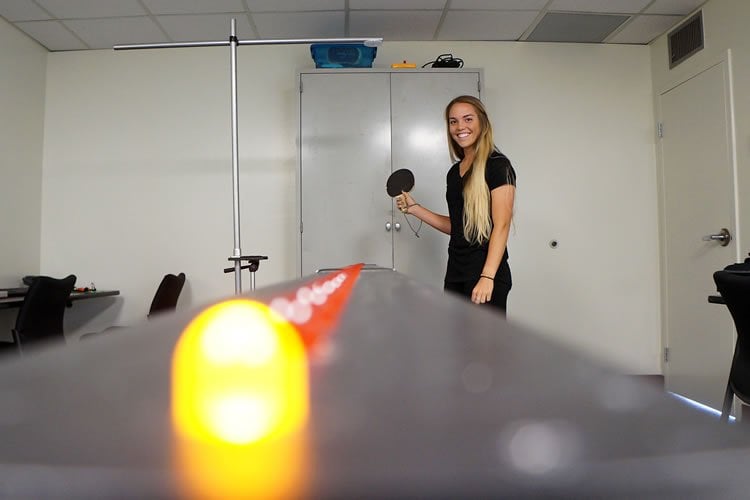Imagine standing on a basketball court, throwing the basketball and watching it arc into the net, followed by a soft swoosh sound.
Chances are you’ll make that shot without a problem if you’ve been practicing on the court regularly, according to research by Phillip Post, associate professor in the Kinesiology and Dance Department in the College of Education at New Mexico State University. Post is studying the link between imagery and how it impacts motor learning and sport performance. Recently, Post presented his research at an international conference at Universidad Autónoma de Chihuahua.
“Specifically, I presented research, mostly research that I conducted, on the efficacy of using imagery to enhance learning or motor performance of well-rehearsed tasks,” Post said. “The research presented suggests that imagery might be effective for enhancing learner’s skill acquisition of tasks that contain greater cognitive elements, such as tasks that require decision making or remembering a sequence or pattern, as opposed to motor elements, or tasks that require correct skill execution, like a soccer kick. However, with more experienced performers imagery appears to be effective on a range of tasks, including both motor and cognitive. In addition to this research I discussed imagery theories and how to best apply the mental skill.”
At his lab on campus, Post is exploring two different lines of research. One looks at the application of imagery, particularly looking at allowing learners to acquire new skills and seeing how mentally rehearsing a particular sports skill or motor task affects their skill acquisition of it. The other looks at how imagery enhances the performance of well-rehearsed skills.
“We look at that in terms of the mental strategy of learning and also in terms of sport performance. We also do some basic motor learning types of experiments in here to see what practice conditions facilitate skill acquisition,” Post said. “We want to apply these not only to instructional settings but also to rehab settings, where practitioners need to design practice protocols that are going to facilitate their patients’ skill acquisition skills or help them relearn skills.”
As part of his research, Post uses an anticipation timing device where participants use a ping pong paddle to time their swing as a line of light bulbs turn on, mimicking the path of a ping pong ball.
“When you try to catch a baseball or an object, you have to be able to time it so that when the object arrives to you, you have your hands up with the arrival of that particular ball or object,” Post said. “It’s pretty prominent with a lot of daily skills, things such as driving or sports. We want to be on target so that we are arriving at the location of where that ball or that object is going to be.”
Post said the device allows him to measure to the millisecond how good participants are at timing their responses. He uses three groups to conduct his research: a group that physically practices their timing, a group that images their timing and a “combo” group that prepares both physically and mentally. He also uses a control group.
“With this apparatus, we want to know can learners improve their ability to intercept a light upon its arrival at a target location,” Post said. “How does mentally rehearsing affect a participant’s ability to learn this particular task?”
Ray Delgado, an NMSU kinesiology major and Post’s undergraduate research assistant, said he became interested in the research after playing college baseball for three years.

“I was taking sports psychology with Dr. Post and he talked about the different things we’ve worked on in here. It really sparked my interest,” said Delgado, who plans to pursue a doctoral degree in physical therapy. “In the long run, this helps me see how I can apply some of these strategies in therapy to see how we can use imagery in therapy and assist the rehab process.”
Post said he hopes that in the near future, his research will help patients who have suffered a stroke or have been diagnosed with diseases such as Parkinson’s.
“We hope to run interventions or studies to help the various clinical populations reacquire tasks faster and reduce their physical therapy time,” Post said.
NMSU associate kinesiology professor Phillip Post is conducting research on how imagery ties into sports performance. He hopes that his research will one day be applied to physical therapy patients, including those who have suffered a stroke or have been diagnosed with Parkinson’s Disease.
Robert Wood, the interim associate dean of research for the College of Education, said he’s impressed with Post’s work.
“The imagery work has many important applications, including human performance and rehabilitation,” Wood said. “I am very excited about Dr. Post’s work, not only because of the relevance to contemporary issues, but also because of the high quality of the work. We are quite fortunate to have him.”
Source: Adriana M. Chavez – New Mexico State University
Image Source: The image is credited to Adriana M. Chavez
Video Source: The video is available at the nmsunews YouTube page







